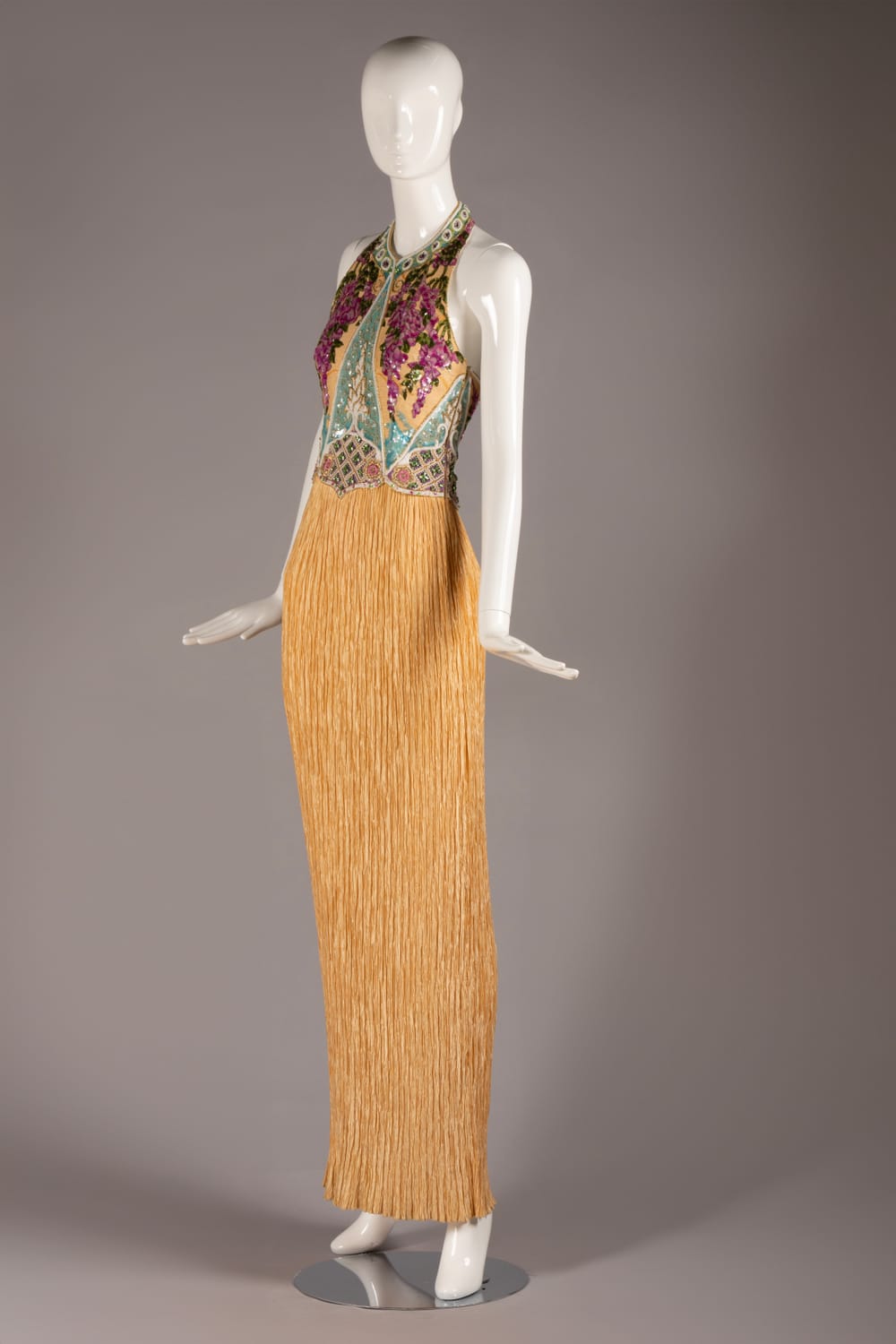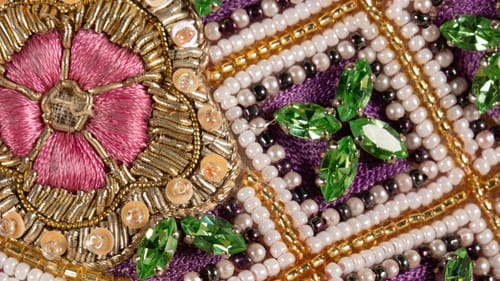Stay in the Loop
BSR publishes on a weekly schedule, with an email newsletter every Wednesday and Thursday morning. There’s no paywall, and subscribing is always free.
A “design archeologist” arrives at Drexel
Drexel University presents Modern Ritual: The Art of Mary McFadden

Fashion designer Mary McFadden once told an interviewer that she thought she would be a globetrotting journalist, telling stories around the world. And in a way, that’s exactly what she did, in the form of exquisite clothing incorporating influences of architecture, painting, textiles, and beading from many different cultures and eras. Now, Modern Ritual: The Art of Mary McFadden, on display at Drexel’s Robert and Penny Fox Historic Costume Collection, offers a tantalizing glimpse of that world.
This compressed exhibition features ensembles from the 1970s through the 1990s. Having only recently received McFadden’s archive at Drexel, curator Rachel Sepielli hopes to show more of the designer’s work and life in the future. Fans of women artists, global design, and haute couture will hope so too.
Intimate, distinctive, and bold
The intimate, dimly lit exhibit room features three freestanding cases and one long, encased wall of runway samples including gowns and long, robe-like jackets, with only a few shorter outfits. Sepielli chose to organize the displays based on McFadden’s creative use of materials, rather than chronology. Viewers therefore encounter thematic groupings that include hand-painted fabrics, pleating, beading and embroidery, beading with embellishments such as gold macramé, and printed cottons.
Mark Willie’s graphics for the exhibition are appropriately bold, taking advantage of McFadden’s distinctive signature. Occasional paper offerings, such as a letter to the designer from activist Gloria Steinem on Ms. Letterhead, broaden the understanding of her influence. The display labels for each design, while small, are unusually interesting. They offer insights into McFadden’s inspiration and production, how and where the pieces were worn, and even some anecdotes about how the piece was originally photographed.
The birth of Marii pleating
McFadden’s iconic Marii pleating is evident throughout. These tight, sinuous lines are ubiquitous today, even in fast fashion brands, and are a hallmark of Japanese designer Issey Miyake (although his pleating process differs). But Marii pleating constituted a technical breakthrough by the designer. Early in the 20th century, Venetian designer Mariano Fortuny patented a method of creating tiny, crenelating pleats in silk to drape the body in a style reminiscent of ancient Greece. However, those garments could be worn only a few times before they had to be returned to the designer for re-pleating … or discarded.
McFadden astutely moved from silk to polyester, sourced in Australia. The fabric was then dyed in Japan to her exacting specifications for each season, and transformed into the indestructible Marii pleats via an elaborate process that took years to perfect. The resulting columnar silhouette is shown topped by regal painted and quilted silk coats, corseted in velvet, cinched with gold braid, and stunningly beaded—sometimes so heavily that the garments could not be stored on hangers. Each collection was inspired by a different ancient civilization. As a result, Harold Koda, former curator-in-chief of the Costume Institutes at the Metropolitan Museum of Art, dubbed McFadden a “design archaeologist.” These dresses attracted wearers ranging from Steinem to First Lady Jacqueline Kennedy.
Global citizen, shrewd businesswoman
Along with the opulence and originality of her designs, McFadden is an adroit businesswoman. She parlayed family wealth and matrimonial social connections (she claims 11 marriages) into jobs in fashion journalism and PR with the likes of Christian Dior and Henri Bendel, opening the door to her own collections. Sourcing materials from one part of the world, she took them elsewhere for dyeing, painting, beading, and sequin appliqué, creating wearable yet elevated and timeless silhouettes. Vintage McFadden pieces are still popular scores from web resellers today.
Some of the dresses on display at Drexel are entirely encrusted in beading (done in India), while others are daringly sheer, with strategic medallions offering a modicum of modesty. When asked about the appropriate slip for a gown, McFadden supposedly replied that her garments needed nothing whatsoever underneath them. Now aged 85, McFadden says that she stopped producing collections because fashion became globally generic and demand for couture clothing waned.
Access in fashion
This show raises many questions of representation and access. For example, all of the outfits on display are sized 0 to 2, shown on six-foot, one-inch alabaster mannequins—though these loose, comfortably elegant garments could adorn many kinds of bodies. While there’s no way to bring size diversity retroactively to an archival collection, it is past time to move away from all-white display figurines and instead indicate a variety of skin tones. This is especially true given that McFadden drew her inspiration from regions such as South Africa, Egypt, India, and Japan.
Visitors cannot walk in solo: they must call ahead to book a curator-guided tour (info below). This affords an unusual degree of insight and a great opportunity for personal questions. However, anyone with visual difficulties will probably struggle with the fabric-protective low light and small labels for each ensemble.

As a research university with a College of Engineering and a pioneering Center for Functional Fabrics, Drexel has the capacity to offer much more in the way of access. For example, QR codes leading to audio descriptions on smartphones are now commonplace in museums; raised QR codes for blind or low-vision visitors are easy to source (discussion of accessibility strategies is available from the American Alliance of Museums).
Fashion is an admittedly visual medium, but it is also highly tactile. Many cultural institutions are now offering innovative hands-on options for low-vision or blind audiences. Why not offer McFadden visitors a touch table with samples of Marii pleated fabric? Could enterprising students in design and/or engineering attempt to replicate some of the beading through 3-D printing? Especially since the fragile garments must stay in a case, such tactile experiences would benefit everyone, sighted or not. And in future exhibitions, video or audio kiosks illuminating McFadden’s life and influences could augment the space—interviews with her abound online.
The benefits of a costume archive being housed inside a university should include innovative approaches to display that strive for greater inclusiveness and push boundaries—as McFadden did herself.
Visitors can access the show (Tuesdays through Fridays, 12-5pm) by scheduling an appointment with Rachel Sepielli: call (215) 571-3249 or email [email protected].
At top: A McFadden gown on view at the URBN Center, showing a beaded bodice and McFadden’s signature Marii pleating. (Photo courtesy of Drexel University.)
What, When, Where
Modern Ritual: The Art of Mary McFadden. Through October 11, 2024, at Drexel University’s URBN Center, 3501 Market Street (via the Filbert Street rear entrance), Philadelphia. (215) 571-3249 or drexel.edu.
Accessibility
The URBN Center is a wheelchair-accessible venue with gender-neutral restrooms.
Sign up for our newsletter
All of the week's new articles, all in one place. Sign up for the free weekly BSR newsletters, and don't miss a conversation.

 Wendy Univer
Wendy Univer